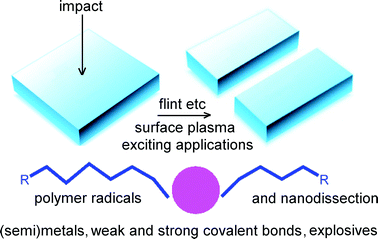Mechanochemistry means mechanical breakage of intramolecular bonds by external force and must be differentiated from molecular solid-state chemistry, where contacts between micronized molecular solids are created by the mechanical action for mutual approach of the reacting centers. After an outline of the mechanistic differences, the varied mechanochemistry is discussed. Grinding, milling, shearing, scratching, polishing, and rapid friction (for polymers also cutting, kneading, extruding) provide the mechanical impact for mechanochemistry, while sonication and shock waving for intramolecular bond breaking are generally described as thermal processes. The various types of mechanophysics (e.g., mechanoelectricity, conformational changes, thixotropy, rheopexy, stirring of Newtonian liquids or suspensions, etc.) are not treated here. Mechanochemistry covers solid-state reactions of infinitely covalent crystals, brittle metals, polymers, molecular solids with weak covalent bonds, strong intramolecular bond breakage in shearing Bridgman's anvil or by friction at lubrication of rapidly moving cold contacting surfaces, and single bond breaking or cutting. The diverse wealth of practical applications of mechanochemistry is outlined with typical examples for ceramics, mechanical alloying, hydrogen storage, organic syntheses, waste remediation, leachings, surface plasmas, radical formation, explosives, nanotube formation, nanoparticles grafting, polymer technology, radical initiation, scratch-less polishing, wear protection, lubrication, mechanochromism, nano-dissection, and many more.


 Please wait while we load your content...
Please wait while we load your content...